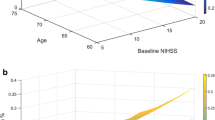Abstract
Intravenous (i.v.) recombinant tissue plasminogen activator (rt-PA) should be available on a 24/7 basis in hospitals admitting patients with stroke. We aimed at evaluating the influence of the number of patients previously treated with i.v. rt-PA by neurologists on patients’ outcome. For each patient consecutively treated with i.v. rt-PA for cerebral ischaemia at the Lille University Hospital, we determined the number of previous treatments with rt-PA administered by the neurologist. We performed logistic regression analyses to determine the influence of the experience on the outcome evaluated by the modified Rankin scale (mRS) after 3 months, 0–1 meaning independence, and 0–2 meaning absence of handicap. We compared outcomes of patients treated by the 25 % less experienced neurologists with those of trials. Forty-four neurologists treated 800 patients. The experience of the treating neurologist was independently associated with independence (adjusted odds ratio [adjOR] 1.062 for 10 patients more; 95 % confidence interval [CI] 1.008–1.120), and absence of handicap (adjOR 1.076 for 10 patients more; 95 %CI 1.016–1.140) at 3 months, but not with symptomatic intracerebral haemorrhage and death. The proportions of patients from the 1st quartile who were independent and without handicap at 3 months were 37.9 and 51.1 %. Patients treated by less experienced neurologists, have similar outcomes than expected from trials, suggesting they benefit from thrombolysis. However, the outcome of patients treated by more experienced neurologists was slightly better. Less experienced neurologists should not be excluded from rt-PA programmes, but their practices should be evaluated and educational programmes organised.


Similar content being viewed by others
References
Van Swieten JC, Koudstaal PJ, Visser MC et al (1988) Interobserver agreement for the assessment of handicap in stroke patients. Stroke 19:604–607
The National Institute of Neurological Disorders and Stroke rt-PA Stroke Study Group (1995) Tissue plasminogen activator for acute ischemic stroke. New Engl J Med 333:1581–1587
Hacke W, Kaste M, Bluhmki E et al (2008) Thrombolysis with alteplase 3 to 4.5 hours after acute ischemic stroke. N Engl J Med 359:1317–1329
Hacke W, Donnan G, Fieschi C et al (2004) Association of outcome with early stroke treatment: pooled analysis of ATLANTIS, ECASS, and NINDS rt-PA stroke trials. Lancet 363:768–774
Lees KR, Bluhmki E, von Kummer R et al (2010) Time to treatment with intravenous alteplase and outcome in stroke: an updated pooled analysis of ECASS, ATLANTIS, NINDS, and EPITHET trials. Lancet 375:1695–1703
The European Stroke Organisation (ESO) executive committee (2008) Guidelines for management of ischaemic stroke and transient ischaemic attack 2008. Cerebrovasc Dis 25:457–507 (see update at: http://www.eso-stroke.org)
Curtze S, Meretoja A, Mustanoja S, Putaala J, Lindberg T, Leppä M, Tiainen M, Atula S, Tatlisumak T, Kaste M, Artto V, Häppölä O, Lindsberg PJ, Piironen K, Pitkäniemi J, Rantanen K, Sairanen T, Salonen O, Silvennoinen H, Soinne LSD (2012) Does time of day or physician experience affect outcome of acute ischemic stroke patients treated with thrombolysis? A study from Finland. Int J Stroke 7:511–516. doi:10.1111/j.1747-4949.2012.00795.x
Cordonnier C, Girot M, Dorp E et al (2000) Stroke units from scientific evidence to practice: the experience of the Lille stroke unit. Cerebrovasc Dis 10(Suppl 4):17–20
Bodenant M, Leys D, Debette S et al (2010) Intravenous thrombolysis for acute cerebral ischaemia: comparison of outcomes between patients treated at working versus nonworking hours. Cerebrovasc Dis 30:148–156
Hacke W, Kaste M, Fieschi C et al (1998) Randomised double-blind placebo-controlled trial of thrombolytic therapy with intravenous alteplase in acute ischaemic stroke (ECASS II). Second European-Australasian Acute Stroke Study Investigators. Lancet 352:1245–1251
Lyden P, Brott T, Tilley B et al (1994) Improved reliability of the NIH Stroke Scale using video training. NINDS TPA Stroke Study Group. Stroke 25:2220–2226
Adams HP Jr, Bendixen BH, Kappelle LJ et al (1993) Classification of subtype of acute ischemic stroke. Definitions for use in a multicenter clinical trial. TOAST. Trial of Org 10172 in Acute Stroke Treatment. Stroke 24:35–41
Bendel RB, Afifi AA (1977) Comparison of stopping rules in forward regression. J Am Stat Ass 72:46–53
Glantz SA, Slinker BK (1990) Primer of applied regression and analysis of variance. McGraw Hill, New York
Wahlgren N, Ahmed N, Davalos A et al (2007) Thrombolysis with alteplase for acute ischaemic stroke in the Safe Implementation of Thrombolysis in Stroke-Monitoring Study (SITS-MOST): an observational study. Lancet 369:275–282
Sandercock P, Wardlaw JM, Lindley RI et al (2012) The benefits and harms of intravenous thrombolysis with recombinant tissue plasminogen activator within 6 h of acute ischaemic stroke (the third international stroke trial [IST-3]): a randomised controlled trial. Lancet 379:2352–2363
Boulouis G, Dumont F, Cordonnier C et al (2012) Intravenous thrombolysis for acute cerebral ischaemia in old stroke patients ≥80 years of age. J Neurol 259:1461–1467
Dzialowski I, Pexman JHW, Barber PA et al (2007) Asymptomatic hemorrhage after thrombolysis may not be benign: prognosis by hemorrhage type in the Canadian alteplase for stroke effectiveness study registry. Stroke 38:75–79
Conflicts of interest
Didier Leys, Hilde Hénon, Stéphanie Debette and Charlotte Cordonnier have been investigators for the ECASS-3 trial (honorarium paid to Adrinord). Amélie Tuffal, Solène Moulin, Nelly Dequatre-Ponchelle, Marie Bodenant, Frédéric Dumont, and Catherine Lefebvre declare no conflict of interest.
Ethical standards
The stroke database of Lille was submitted to the institutional data protection board and to the Human Subject Protection Committee of the Lille University hospital. The study was considered as observational by the internal review board (Comité de protection des personnes Nord Ouest IV, Comité consultatif sur le traitement de l’information en matière de recherche dans le domaine de santé).
Author information
Authors and Affiliations
Corresponding author
Rights and permissions
About this article
Cite this article
Tuffal, A., Moulin, S., Dequatre-Ponchelle, N. et al. Influence of neurologists’ experience on the outcome of patients treated by intravenous thrombolysis for cerebral ischaemia. J Neurol 262, 1209–1215 (2015). https://doi.org/10.1007/s00415-015-7693-8
Received:
Accepted:
Published:
Issue Date:
DOI: https://doi.org/10.1007/s00415-015-7693-8




